<< Previous | Displaying results 4301-4325 of 6769 for "" | Next >>
During World War II, people often used false identities and forged identity documents to evade Nazi authorities. False identities were essential for resistance fighters, aid workers, and Jews hoping to pass as non-Jews. Creating high-quality, convincing forgeries required dozens of people to work together clandestinely. It also required sophisticated photography and printing equipment. For Jews passing as non-Jews, acquiring forged documents could mean the difference between life and death. During World…

During World War II, people often used false identities and forged identity documents to evade Nazi authorities. False identities were essential for resistance fighters, aid workers, and Jews hoping to pass as non-Jews. Creating high-quality, convincing forgeries required dozens of people to work together clandestinely. It also required sophisticated photography and printing equipment. For Jews passing as non-Jews, acquiring forged documents could mean the difference between life and death. This…
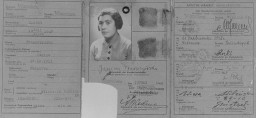
Kurt I. Lewin, who was Jewish, used this card while in hiding in a Ukrainian Greek Catholic monastery in German-occupied Poland (today Ukraine).
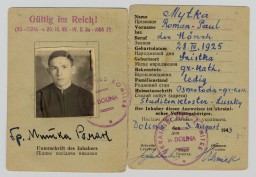
Page from Earl G. Harrison's notebook, recording his impressions of Linz, Austria, while on a tour of displaced persons camps in 1945.
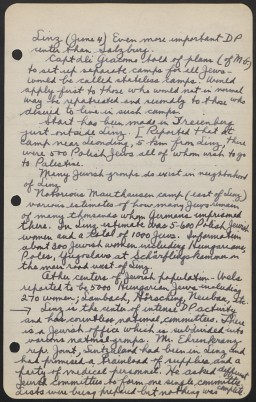
A letter from Salek and Eda Kuenstler to Sophia Zendler promising land in exchange for hiding their daughter.
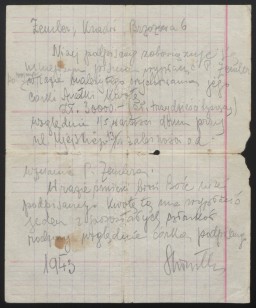
The back of Samuel Soltz's citizenship papers illustrates the vast array of bureaucratic stamps and visas needed to emigrate from Europe in 1940–41. The stamp in the top left, dated August 21, 1940, represents a visa from the Japanese consul to Lithuania, Chiune Sugihara. Sugihara issued thousands of visas to enable Jews to escape.
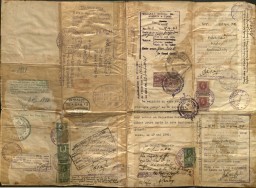
This document from the American Consul-General in Vienna certifies that the Trost family applied for American visas on September 15, 1938. It states that the family (Josef, Alice, Dorrit, and Erika) were placed on the waiting list for visas with the numbers 47291-47294.
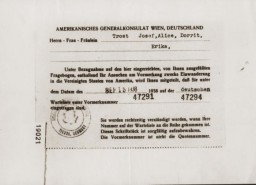
Marriage certificate obtained by Dr. Mohamed Helmy stating that Anna Gutman (Boros) married an Egyptian man in a ceremony held in Helmy’s home. Dr. Helmy also received certification from the Central Islamic Institute in Berlin attesting to Anna’s conversion to Islam, which the marriage certificate reflects. Translation: Marriage certificate On Wednesday June 16, 1943, we have certified the marriage contract between Abdelaziz Helmy Hammad, 36 years old, who was born on May 6th, 1906, in Faqous,…
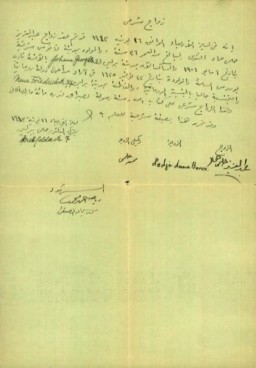
Antisemitic propaganda of an agricultural worker kicking a stereotypically depicted Jewish man through a fence. It reads "German export: Out of our German country with the slimy Jewish band."
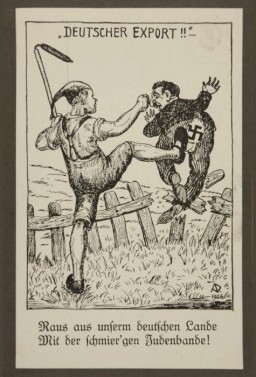
Cartoon depicting Jews, communists, and other enemies of the Nazis hanging on a gallows, 1935
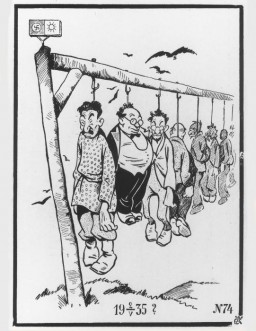
Antisemitic cartoon showing a Jew leading a Soviet official by a leash. It reads "The 'ideal' person for the chosen people: There’s no accounting for taste."
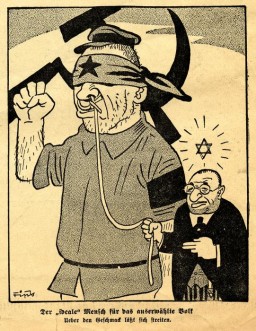
A postcard sent to Ruth Segal (Rys Berkowicz) care of the Jewish Community (JewCom) in Kobe, Japan. Family and friends in German-occupied Warsaw, Poland, sent the postcard on June 20, 1941. It bears stamps both from the Jewish council (Judenrat) in the Warsaw ghetto and from German censors. [From the USHMM special exhibition Flight and Rescue.]
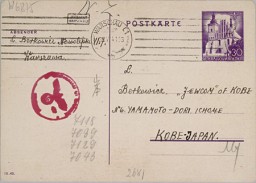
First page of a letter from a US soldier describing "the living dead" and conditions his unit encountered in a subcamp of Dachau in April 1945.
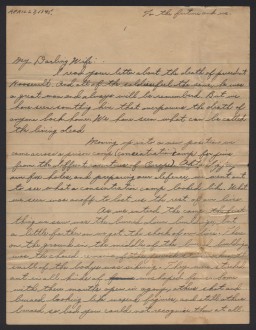
On May 25, 1939, artist Moritz Schoenberger sent this radiogram (a telegram sent by radio) from the ocean liner "St. Louis" during the voyage from Hamburg, Germany, to Havana, Cuba. On this voyage, the "St. Louis" carried over 900 Jewish refugees fleeing Nazi persecution. The telegram reads, in part, "Physically and spiritually recovered and invigorated most confident about reaching Havana Saturday. Money received. Many thanks. Kisses. Papa." Schoenberger's optimism proved unfounded. Cuban authorities…
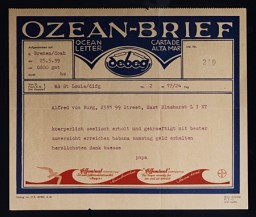
San Francisco Chronicle newspaper article titled "The Refugee Tragedy." The article was based on an interview with Moses Beckelman of the American Jewish Joint Distribution Committee, an aid organization. It discussed the overcrowding of Polish and Lithuanian refugees stranded in Shanghai, Kobe (Japan), and Lisbon (Portugal), all stops en route to North and South America. The primary cause of this bottleneck was a lack of transit and entry visas, a result of most countries closing their borders to…
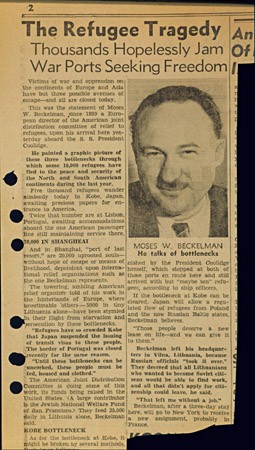
Authorities in Berlin, Germany, sent this notice to Barbara Wohlfahrt, informing her of her husband Gregor's execution on the morning of December 7, 1939. Although he was physically unfit to serve in the armed forces, the Nazis tried Wohlfahrt for his religious opposition to military service. As a Jehovah's Witness, Wohlfahrt believed that military service violated the biblical commandment not to kill. On November 8, 1939, a military court condemned Wohlfahrt to beheading, a sentence carried out one month…

The Dutch government established a camp at Westerbork to intern Jewish refugees who had entered the Netherlands illegally. This sketch of the Westerbork transit camp was made by a Jewish inmate who was able to emigrate to the United States. In early 1942, the German occupation authorities decided to enlarge Westerbork and convert it into a transit camp for Jews. The systematic concentration of Jews from the Netherlands in Westerbork began in July 1942. From Westerbork, Jews were deported to the killing…
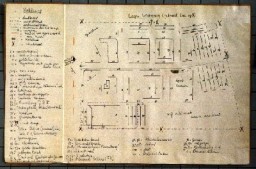
German police authorities issued this passport to Erna "Sara" Schlesinger on July 8, 1939, in Berlin. This first page of the passport illustrates the German laws that facilitated the identification of Jews in Germany. From 1938, German regulations required that Jewish women with a first name of "non-Jewish" origin use the middle name "Sara" on all official documents. Jewish men had to add the name "Israel". The letter "J" (standing for "Jude," that is, the word "Jew" in German) was stamped in red on the…
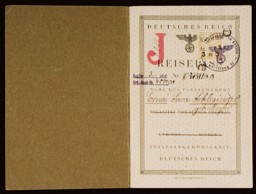
A German passport issued to Alice Mayer on February 24, 1939, in Bingen, Germany. Mayer's daughter, Ellen, is also listed on the passport. Both mother and daughter's names include the middle name "Sara." This middle name became a mandatory addition required by a law of August 17, 1938. Thereafter, all Jewish women in Germany with a first name of "non-Jewish" origin had to add "Sara" as a middle name on all official documents. Jewish men had to add the name "Israel". This enabled German officials to…
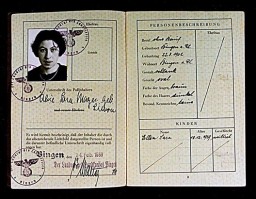
Simone Weil earned this diploma, which certified her to teach kindergarten in France, from the School of Social Work in Strasbourg in 1940. Weil assumed a false identity in late 1943 to facilitate her resistance activities as a member of the relief and rescue organization Oeuvre de Secours aux Enfants (Children's Aid Society; OSE). Among the papers documenting Weil's new identity was a forged version of this diploma bearing the name "Simone Werlin".
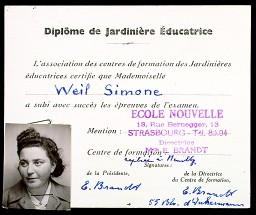
Simone Weil used this forged diploma and other false papers to document a new identity assumed in late 1943. As Simone Werlin, she could avoid arrest and change residence to facilitate her rescue of Jewish children as a member of the relief and rescue organization Oeuvre de Secours aux Enfants (Children's Aid Society; OSE). Weil had earned the diploma, which certified her to teach kindergarten in France, from the School of Social Work in Strasbourg in 1940. The director of the school willingly forged this…
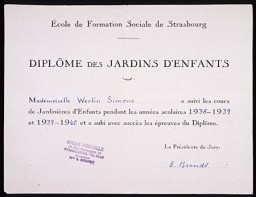
Simone Weil kept this blank identification card bearing her picture in case her cover as "Simone Werlin" were blown and she needed to establish a new false identity. Both resistance workers and sympathetic government employees provided her the necessary stamps and signatures. Such forged documents assisted Weil in her work rescuing Jewish children as a member of the relief and rescue organization Oeuvre de Secours aux Enfants (Children's Aid Society; OSE).
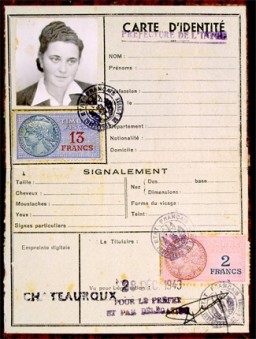
After adopting a new identity in late 1943, Simone Weil falsified her student card from the year 1938-1939 to bear her assumed name, Simone Werlin. The card verified enrollment in the School of Social Work in Strasbourg. Using forged and falsified documents, Weil was able to move to Chateauroux, France, and establish an operation to rescue Jewish children as a member of the relief and rescue organization Oeuvre de Secours aux Enfants (Children's Aid Society; OSE).
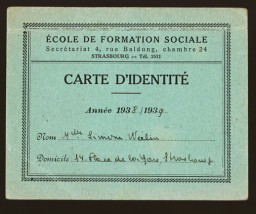
Plan of the two-propeller passenger liner the "St. Louis," showing cabins and room numbers. In 1939, this German ocean liner carried almost 1,000 Jewish refugees seeking temporary refuge in Cuba. It was forced to return to Europe after Cuba and then the United States refused to allow the refugees entry.
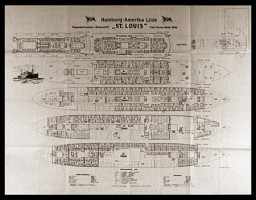
Most Polish Jewish refugees stayed in Japan much longer than their 10-day transit visas allowed. Many feared the day when Japanese authorities would no longer extend their stay with permits like the one shown here. [From the USHMM special exhibition Flight and Rescue.]
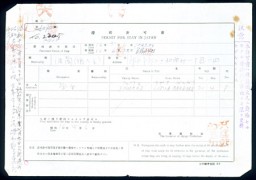
We would like to thank Crown Family Philanthropies, Abe and Ida Cooper Foundation, the Claims Conference, EVZ, and BMF for supporting the ongoing work to create content and resources for the Holocaust Encyclopedia. View the list of donor acknowledgement.